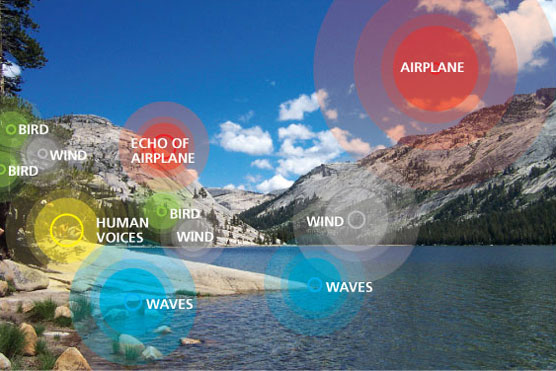You’d be surprised at how few businesses think about sound.
This is mostly due to our physiology: we can close our eyes, but not our ears. Of our fives senses, sound is the most overlooked despite its importance. Because we’re always surrounded by audio input, we tend to ignore unpleasant noises, and this capacity to filter out what we don’t want to hear is why our relationship with sound is so nuanced on a subconscious level. For instance: as you read these words, what is the sound of the world around you?
Try closing your eyes for a moment and notice the multiple layers of sound in your surroundings. All of sudden, a symphony comes to life, right? All that was required is a shift of attention.

If this comes as a surprise, that’s because we are rarely taught to listen. Listening is hearing with attention. Schools test reading, writing, and a bit of speaking, but not listening. This has consequences on our health, our relationships, and our brands.
Fortunately, there is room for improvement. Brands that consciously use sound engage their customers in a more holistic manner: after all, we experience the world through our whole bodies, including the five senses. An influential brand offers an experiential journey that goes far beyond the utility of product/service. Think: sonic logos, music in commercials, and the sounds in your favorite cafe. Think of the default iPhone ring tone and the noise your computer makes when you turn it on.
Now, not every brand needs to devise clever multi-sensory marketing campaigns. However every campaign can consider its audio components. Conscious use of sound gets us out of heads and into our bodies, and how we feel will determine how we act.
While some brands miss out on opportunities to engage their customers through sound, other brands shoot themselves in the foot by inadvertently making or introducing sound into their brand experience without realizing it, without understanding it or without thinking it through.
Consider the example of a restaurant so loud you have to yell in order to ask for the salt. Or the supermarket that plays pop music through cheap, crackling loudspeakers overlaid with the frenzied rumble of freezers, cash register beeps, and squeaky shopping cart wheels. It’s a lose-lose situation. Customers don’t enjoy it—consciously or unconsciously—and ultimately the business loses in sales.

As both quantum physicists and ancient sages confirm, all matter vibrates and thus, makes sound. The world is comprised of sound, we only hear a small portion of it.
As individuals, we can learn to listen to the world outside and the world inside ourselves.
In our work spaces, we can create diverse sonic environments that respect both the need for quiet, as well the need for energizing buzz and ambient sound.
For businesses, thinking about and planning for intentional sound provides an empathic way to understand their brand, their customers and their role in the world.
Listening is both an action of the ear and an action of the heart.